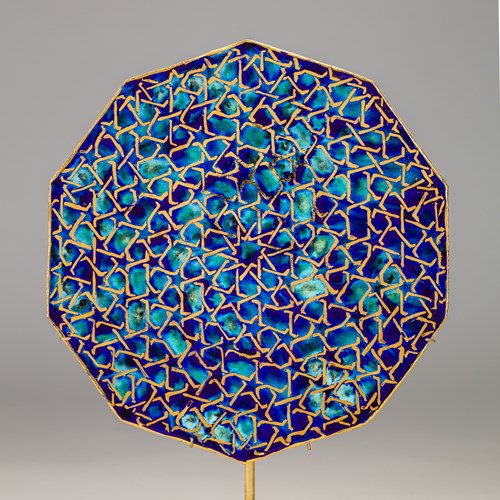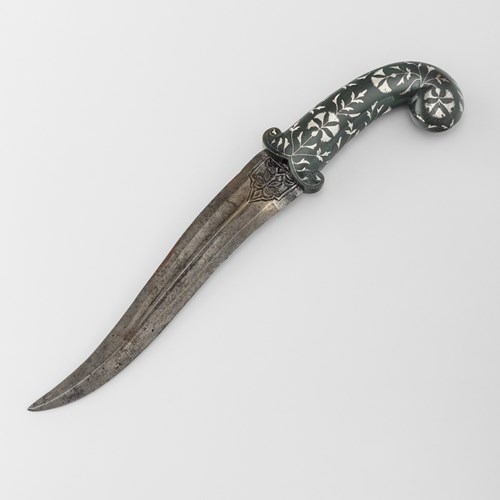Marketplace
Sugrai Ragini
Sugrai Ragini
Date 1760
Period 1750-1850, 18th century
Origin India, Hyderabad, Telangana
Medium Ink, Gold on paper, Opaque watercolor
Dimension 24 x 15 cm (9¹/₂ x 5⁷/₈ inches)
24cm high, 15cm wide (43.5cm high, 34cm wide framed)
A number of Ragamala series were produced at Hyderabad during the mid-18th century. They offer iconography that is consistent with many sets in the north from Mughal and Rajasthani centres, but display some other titles. Sugrai (also called Sukhrai) is one of these rare raginis with iconographies that appear to be only found in these sets, although the iconography can be compared to a typical ragini called Malavi where a lady is often shown outside a pavilion holding one mala (garland) or two. Here Sugrai embraces her paramour who holds the mala. They walk towards the terrace of a marble pavilion where the maid lays out the bed.
A verse on a similar painting describes the scene:
Six hours after sunrise. The lover with coquetry, takes the beloved into the bed chamber. The attendant, being ashamed of this act, turns away her face.
These sets are noted for the heavy use of gold, note especially the gold sunset beyond the gateway to the garden, and massive marble architecture. The use of bold diagonals creating deep spatial settings is also a common feature to these sets. Heavily ornamented geometric shapes, the carpet and flower beds as well as the gold brocades of the pillow and garments of the lovers, flattens the composition and negates the recession into space suggested by the architecture.
For the quoted text from a series in the Prince of Wales Museum, Bombay, acquisition no. 22.287-322 (Sugrai would be 22.319) see: Klaus Ebeling, Ragamala Painting, Basel: Ravi Kumar, 1973, p. 146. For a related and illustrated full Ragamala set see: Toby Falk and Mildred Archer, Indian Miniatures in the India Office Library, London, Sotheby's Parke Bernet, 1981, #426 (Johnson Album 37), p. 228-31. Sugrai, no. 27 is illustrated on p. 513.
Stock no.: A4297
A number of Ragamala series were produced at Hyderabad during the mid-18th century. They offer iconography that is consistent with many sets in the north from Mughal and Rajasthani centres, but display some other titles. Sugrai (also called Sukhrai) is one of these rare raginis with iconographies that appear to be only found in these sets, although the iconography can be compared to a typical ragini called Malavi where a lady is often shown outside a pavilion holding one mala (garland) or two. Here Sugrai embraces her paramour who holds the mala. They walk towards the terrace of a marble pavilion where the maid lays out the bed.
A verse on a similar painting describes the scene:
Six hours after sunrise. The lover with coquetry, takes the beloved into the bed chamber. The attendant, being ashamed of this act, turns away her face.
These sets are noted for the heavy use of gold, note especially the gold sunset beyond the gateway to the garden, and massive marble architecture. The use of bold diagonals creating deep spatial settings is also a common feature to these sets. Heavily ornamented geometric shapes, the carpet and flower beds as well as the gold brocades of the pillow and garments of the lovers, flattens the composition and negates the recession into space suggested by the architecture.
For the quoted text from a series in the Prince of Wales Museum, Bombay, acquisition no. 22.287-322 (Sugrai would be 22.319) see: Klaus Ebeling, Ragamala Painting, Basel: Ravi Kumar, 1973, p. 146. For a related and illustrated full Ragamala set see: Toby Falk and Mildred Archer, Indian Miniatures in the India Office Library, London, Sotheby's Parke Bernet, 1981, #426 (Johnson Album 37), p. 228-31. Sugrai, no. 27 is illustrated on p. 513.
Stock no.: A4297
Date: 1760
Period: 1750-1850, 18th century
Origin: India, Hyderabad, Telangana
Medium: Ink, Gold on paper, Opaque watercolor
Dimension: 24 x 15 cm (9¹/₂ x 5⁷/₈ inches)
More artworks from the Gallery




_T638563983608940170.jpg?width=500&height=500&mode=pad&scale=both&qlt=90&format=jpg)

_T638772014586673341.jpg?width=500&height=500&mode=pad&scale=both&qlt=90&format=jpg)


